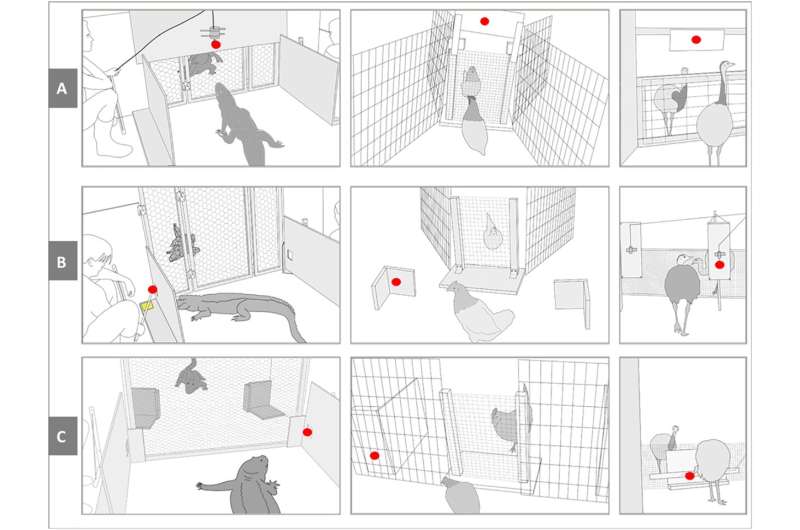This article has been reviewed according to Science X's editorial process and policies. Editors have highlighted the following attributes while ensuring the content's credibility:
fact-checked
peer-reviewed publication
trusted source
proofread
Study suggests dinosaurs were the first to understand the perspectives of others

Understanding that others hold different viewpoints from your own is essential for human sociality. Adopting another person's visual perspective is a complex skill that emerges around the age of 2. A new study from Lund University in Sweden, published in Science Advances, suggests that this ability first arose in dinosaurs, at least 60 million years before it appeared in mammals. These findings challenge the idea that mammals were the originators of novel and superior forms of intelligence in the wake of the dinosaur extinction.
When someone near you turns their head towards something in the environment, you likely can't help to follow their gaze direction. This reaction is observed in mammals, birds and even reptiles alike. It's an effective way to gather information about what caught the attention of your fellow, which you might otherwise have missed.
However, a far more advanced behavior is to follow someone's gaze to a location that is initially obstructed from your view. By repositioning yourself to see what the other person is looking at, you demonstrate an understanding that the other has a different perspective. This ability, known as "visual perspective taking" develops in children between the ages of 1.5 to 2 years and serves as the foundation for later comprehending referential communication and that others have minds that differ from your own.
Visual perspective taking has, to date, only been found in very few species. Mainly in apes and some monkeys, but also in dogs and ravens. However, there is limited knowledge regarding the evolutionary origins of this crucial social skill. A team of researchers from Lund University aimed to investigate a potential early emergence of visual perspective taking in dinosaurs.
Through a comparison of alligators with the most primitive existing birds, known as palaeognaths, they discovered that visual perspective taking originated in the dinosaur lineage likely 60 million years, or more, prior to its appearance in mammals.
Crocodilians are the closest living relatives to birds. Their neuroanatomy has remained largely unchanged for hundreds of millions of years, and is similar to that of the common ancestor of dinosaurs and crocodilians. Palaeognath birds comprise the ostrich birds, such as emus and rheas, but also the flighted tinamous. Their brains are in large part comparable to their forebearers, the non-avian paravian dinosaurs, which feature such celebrities as the velociraptors. Comparing these two groups of animals creates a bracket around the extinct lineage of dinosaurs leading up to modern birds.
The study revealed that alligators do not demonstrate visual perspective taking, although they do follow gaze to a visible location. In contrast, all tested bird species exhibited visual perspective taking. Additionally, the birds engaged in a behavior called "checking back," where the observer looks back into the eyes of the gazer, and re-tracks the gaze, when unable to find anything in the direction of their gaze the first time. This behavior indicates an expectation that the gaze is referring to a target in the environment. Previously, this has only been observed in humans, apes and monkeys, and ravens.
Palaeognath birds emerged 110 million years ago, predating the two mammal groups endowed with visual perspective taking—primates and dogs—with 60 million years. Considering the neuroanatomical similarities between these birds and their non-avian forebearers, it is plausible that the skill originated even earlier in the dinosaur lineage. However, it is less likely to have been present among the earliest dinosaurs, which had more alligator-like brains.
Perhaps future research will show the ability to be more widespread among mammals than currently known, but even if that would be the case it will most probably still be predated by the dinosaur origin. Nevertheless, it is not surprising that visual perspective taking emerged earlier in the dinosaurs, which include the birds, given their superior vision compared to most mammals, that historically relied on nocturnal adaptations. It was only with the emergence of the primates and certain carnivores that our visual capabilities improved.
This is yet another finding that calls into question the prevailing view that mammals drove the evolution of complex cognition, and that they are the cognitive yardstick to which other animals should be compared. An increasing number of studies show the remarkable neurocognition of the avian dinosaurs, the birds, which might prompt a rethinking of the natural history of cognition.
Senior author, Prof. Mathias Osvath says, "Early in my career, crow birds earned the nickname 'feathered apes,' due to numerous research findings that showcased their remarkable cognition. However, I'm beginning to question whether it would be more fitting to consider primates as honorary birds."
First author (then Ph.D.-student), Dr. Claudia Zeiträg, says, "Birds are commonly being overlooked when it comes to their cognitive skills. Our findings show that they do not only have several cognitive skills on par with those of apes, but that their forebearers most likely had these skills long before they evolved in mammals."
Middle author, Dr. Stephan Reber, says, "Crocodilians are ideal models to study the evolutionary origins of cognitive capacities in birds. What they share most probably existed in the common ancestor of dinosaurs and crocodilians. If crocodilians lack an ability birds possess, it likely evolved in the dinosaur lineage after the split. This approach allows us to study the cognition of extinct species."
More information: Claudia Zeiträg et al, Gaze following in Archosauria—Alligators and palaeognath birds suggest dinosaur origin of visual perspective taking, Science Advances (2023). DOI: 10.1126/sciadv.adf0405
Journal information: Science Advances
Provided by Lund University

















